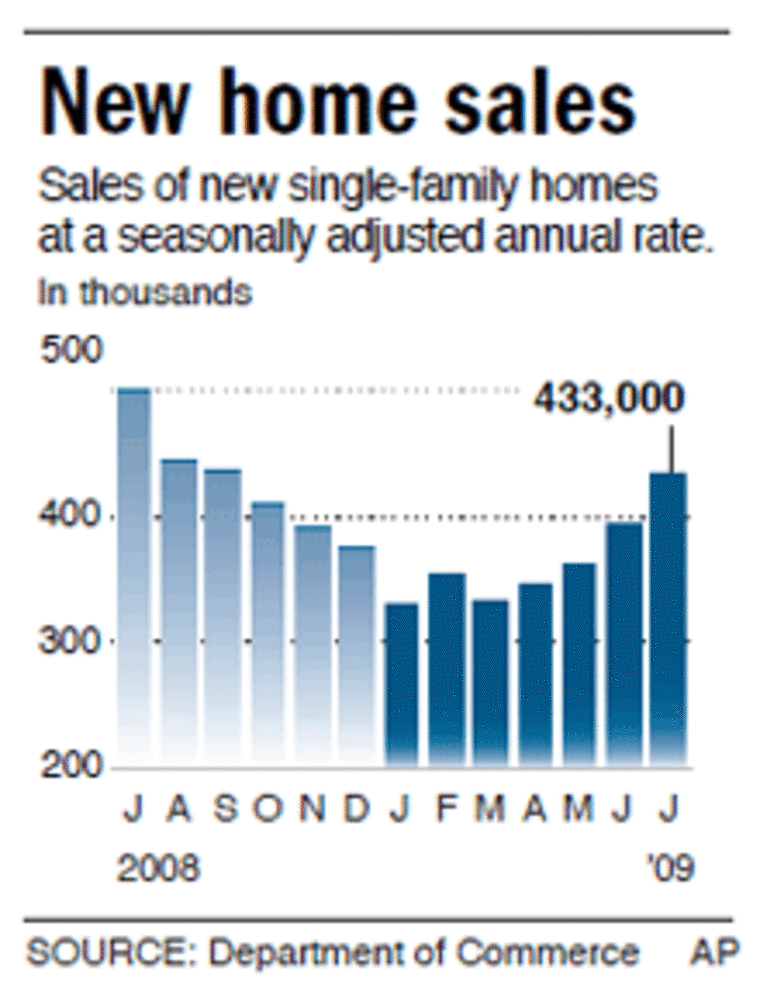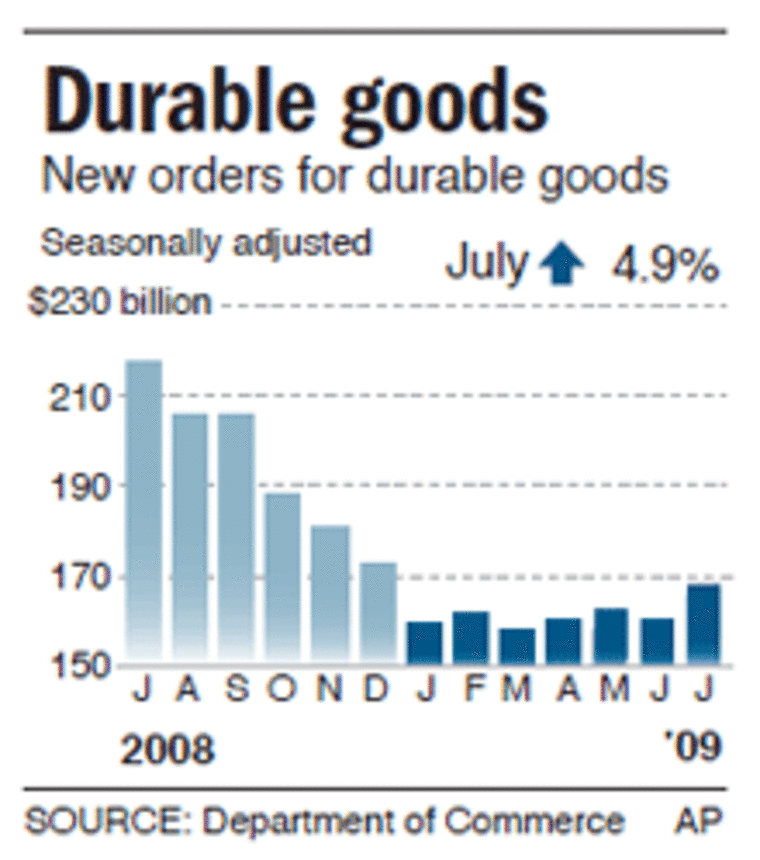Orders for durable goods rose last month by the largest amount in two years, as the manufacturing sector rebounded from the depths of the recession.
The Commerce Department said Wednesday that orders for goods expected to last at least three years increased 4.9 percent in July, the third rise in the past four months. Analysts expected a 3 percent increase. Orders for June were revised up to a 1.3 percent drop, from a 2.2 percent decline.
More good news came on the housing front. New U.S. home sales jumped 9.6 percent in July, a fourth straight monthly gain that beat analysts’ expectations.
The Commerce Department said home sales rose to a seasonally adjusted annual rate of 433,000 from an upwardly revised June rate of 395,000. But the median sales price of $210,100, was down 11.5 percent from $237,300 a year earlier.
The better-than-expected durable goods and housing data followed positive readings Tuesday about consumer sentiment and home prices. But analysts remain concerned that all-important consumer spending will stay muted as Americans try to rebuild savings decimated by falling home prices and reduced stock portfolios.
“The factory sector is obviously enjoying a rebound in demand, some of it from abroad and some of it linked to inventory rebuilding,” Paul Ashworth, senior economist at Capital Economics, wrote in a note to clients. “However, with the consumer still supine, we don’t yet have the foundations for a sustainable recovery.”
Economists are looking for other parts of the economy, such as business spending, to take up the slack.
The durable goods report, however, showed that orders for non-defense capital goods excluding aircraft, a key measure of business investment, dropped 0.3 percent. Some economists expected that category to fall after rising in May and June.
Still, in the past three months that category has grown by 15.5 percent, Ashworth said.
The financial markets edged up in morning trading after the housing data were released. The Dow Jones industrial average added 25 points, and broader indices also rose.
Orders for transportation equipment, which rose 18.4 percent, drove the overall increase in durable goods. Commercial aircraft orders, a volatile category, more than doubled after falling 30 percent in June. Motor vehicle orders increased 0.9 percent.
Excluding transportation goods, orders rose 0.8 percent. That was the third straight increase, but just below analysts’ expectations of a 0.9 percent rise.
Economists at Barclays Capital said before the report that orders for Boeing Co. aircraft rose in July to their highest level since last August.

Auto production improved last month as General Motors and Chrysler reopened many plants that were shut in May and June while the companies restructured and emerged from bankruptcy protection. The industry also benefited from the government’s Cash for Clunkers program, which spurred thousands of people to trade in older vehicles for new cars.
Growth in the auto sector also boosted orders for steel, aluminum and other primary metals.
“Now the question is whether or not these gains can be sustained without government incentives,” said Tim Quinlan, an economic analyst at Wells Fargo Securities.
Ford Motor Co. earlier this month said its sales rose 2.4 percent in July from the same month last year, its first year-over-year increase since November 2007. Chrysler Group LLC posted a smaller year-over-year sales drop compared with recent months, helped by clunkers deals. GM’s sales fell 19.4 percent, a slower pace than earlier this year.
Tuesday’s consumer and housing reports, along with President Barack Obama’s reappointment of Ben Bernanke as Federal Reserve chief, sent the financial markets modestly higher. But economists warned that consumer confidence remains far below levels associated with a healthy economy and might not lead to the increased spending critical for a broad recovery.
The New York-based Conference Board said its Consumer Confidence index rose to 54.1, from an upwardly revised 47.4 in July. That reading reversed two months of decline and beat analysts’ expectations. Economists closely monitor confidence because consumer spending accounts for about 70 percent of U.S. economic activity.
Consumer sentiment, fueled by signs the economy is stabilizing, has recovered a bit since hitting a record-low of 25.3 in February. A reading of 90 indicates the economy is on solid footing; anything above 100 signals strong growth.
Consumers’ expectations for the economy over the next six months rose to 73.5 from 63.4 in July, the highest level since December 2007, when the recession began.

On the housing front, the Standard & Poor’s/Case-Shiller’s U.S. National Home Price Index rose 1.4 percent in the second quarter from the January-March period, the first quarterly increase in three years. Home prices, though still down nearly 15 percent from last year, are at levels last seen in early 2003.
Many analysts expect the economy to grow 2-3 percent in the current July-September quarter, spurred by a more stable housing market and the clunkers program.
Still, jobs are a weak spot and could limit future consumer spending if Americans remain concerned about layoffs or declining wages.
Obama economic adviser Christina Romer predicted Tuesday that unemployment could reach 10 percent this year and average 9.8 percent next year. That’s up from its current level of 9.4 percent.
